The Dark Waggon.
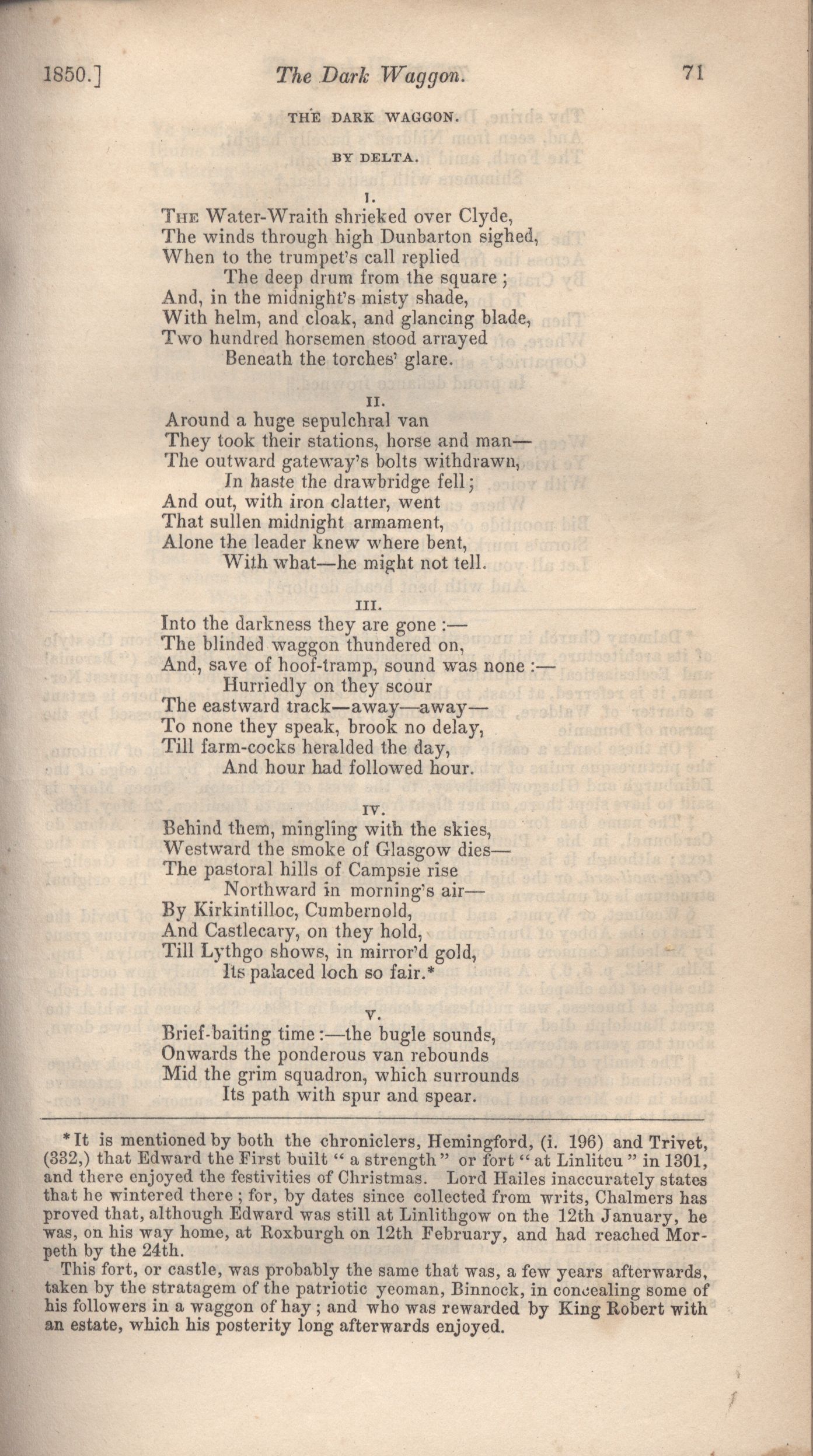
I.
The Water-Wraith shrieked over Clyde,1
The winds through high Dunbarton sighed,2
When to the trumpet’s call replied3
The deep drum from the square ;4
And, in the midnight’s misty shade,5
With helm, and cloak, and glancing blade,6
Two hundred horsemen stood arrayed7
Beneath the torches’ glare.8
II.
Around a huge sepulchral van9
They took their stations, horse and man—10
The outward gateway’s bolts withdrawn,11
In haste the drawbridge fell ;12
And out, with iron clatter, went13
That sullen midnight armament,14
Alone the leader knew where bent,15
With what—he might not tell.16
III.
Into the darkness they are gone :—17
The blinded waggon thundered on,18
And, save of hoof-tramp, sound was none :—19
Hurriedly on they scour20
The eastward track—away—away—21
To none they speak, brook no delay,22
Till farm-cocks heralded the day,23
And hour had followed hour.24
IV.
Behind them, mingling with the skies,25
Westward the smoke of Glasgow dies—26
The pastoral hills of Campsie rise27
Northward in morning’s air—28
By Kirkintilloc, Cumbernold,29
And Castlecary, on they hold,30
Till Lythgo shows, in mirror’d gold,31
Its palaced loch so fair.*32
V.
Brief-baiting time :— the bugle sounds,33
Onwards the ponderous van rebounds34
Mid the grim squadron, which surrounds35
Its path with spur and spear.36
* It is mentioned by both the chroniclers, Hemingford, (i. 196) and Trivet,
(332,) that Edward the First built “ a strength ” or fort “ at Linlitcu ” in 1301,
and there enjoyed the festivities of Christmas. Lord Hailes inaccurately states
that he wintered there ; for, by dates since collected from writs, Chalmers has
proved that, although Edward was still at Linlithgow on the 12th January, he
was, on his way home, at Roxburgh on 12th February, and had reached Mor-
peth by the 24th.
(332,) that Edward the First built “ a strength ” or fort “ at Linlitcu ” in 1301,
and there enjoyed the festivities of Christmas. Lord Hailes inaccurately states
that he wintered there ; for, by dates since collected from writs, Chalmers has
proved that, although Edward was still at Linlithgow on the 12th January, he
was, on his way home, at Roxburgh on 12th February, and had reached Mor-
peth by the 24th.
This fort, or castle, was probably the same that was, a few years afterwards,
taken by the stratagem of the patriotic yeoman, Binnock, in concealing some of
his followers in a waggon of hay ; and who was rewarded by King Robert with
an estate, which his posterity long afterwards enjoyed.
taken by the stratagem of the patriotic yeoman, Binnock, in concealing some of
his followers in a waggon of hay ; and who was rewarded by King Robert with
an estate, which his posterity long afterwards enjoyed.

Thy shrine, Dumanie, fades on sight,*37
And, seen from Niddreff’s hazelly height,38
The Forth, amid its islands bright,39
Shimmers with lustre clear.†40
VI.
The Maiden Castle next surveyed,41
Across the furzy hills of Braid,42
By Craig-Milor, ‡through Wymet’s glade43
To Innerese they wound ;§44
Then o’er the Garlton crags afar,45
Where, oft a check to England’s war,46
Cospatrick’s stronghold of Dunbar47
In proud defiance frowned.‖48
VII.
Weep, through each grove ye tearful rills !49
Ye ivied caves, which Echo fills50
With voice, lament ! Ye proud, free hills,51
Where eagles whee! and soar,52
Bid noontide o’er your summits throw53
Storm’s murkiest cloud ! Ye vales below,54
Let all your wild-flowers cease to blow,55
And with bent heads deplore !56
* Dalmeny Church is unquestionably of very great antiquity. From the style
of its architecture, which a most competent authority, Mr. Billings, ( “ Baronial
and Ecclesiastical Antiquities,” vol. i) has pronounced to be of the purest Nor-
man, it is referred, at least, to the tenth or eleventh centuries. There is extant
a charter of Waldeve, Earl of Dunbar, from 1166 to 1182, witnessed by the
parson of Dumanie.
of its architecture, which a most competent authority, Mr. Billings, ( “ Baronial
and Ecclesiastical Antiquities,” vol. i) has pronounced to be of the purest Nor-
man, it is referred, at least, to the tenth or eleventh centuries. There is extant
a charter of Waldeve, Earl of Dunbar, from 1166 to 1182, witnessed by the
parson of Dumanie.
† On these banks a castle was afterwards erected by the Earls of Wintoun,
the picturesque ruins of which are yet a prominent object, by the edge of the
Edinburgh and Glasgow Railway, to the west of Kirkliston. Queen Mary is
said to have slept there, on her flight from Lochleven to Hamilton, 2d May, 1568.
the picturesque ruins of which are yet a prominent object, by the edge of the
Edinburgh and Glasgow Railway, to the west of Kirkliston. Queen Mary is
said to have slept there, on her flight from Lochleven to Hamilton, 2d May, 1568.
‡ The name has for centuries been vulgarised into Craigmillar. Adam de
Cardonnel, in his “ Picturesque Antiquities,’ adheres to the spelling in the
text ; although it is generally now admitted that the appellation is Gaelic—
Craig-moil-ard, or the high bare rock running out into a plain. The original
structure is of unknown antiquity.
Cardonnel, in his “ Picturesque Antiquities,’ adheres to the spelling in the
text ; although it is generally now admitted that the appellation is Gaelic—
Craig-moil-ard, or the high bare rock running out into a plain. The original
structure is of unknown antiquity.
§ Woolmet, or Wymet, and Innerese, were granted by charter of David the
First to the Abbey of Dunfermline; the latter in confirmation of a previous grant
by Malcolm Canmore and Queen Margaret, (‘* Registrum de Dunformlyn,” Imp.
Edin. 1842, p. 5,6.) A small mausoleum of the Wauchope family now occupies
the site of the chapel of Wymet; and the venerable pile of St. Michael the Arch-
angel, at Inneresc, was ruthlessly demolished in 1804. The house in which the
great Randolph died, which was about half a mile distant, was also hewn down,
about ten years afterwards, to make way for a shabby masonic lodge.
First to the Abbey of Dunfermline; the latter in confirmation of a previous grant
by Malcolm Canmore and Queen Margaret, (‘* Registrum de Dunformlyn,” Imp.
Edin. 1842, p. 5,6.) A small mausoleum of the Wauchope family now occupies
the site of the chapel of Wymet; and the venerable pile of St. Michael the Arch-
angel, at Inneresc, was ruthlessly demolished in 1804. The house in which the
great Randolph died, which was about half a mile distant, was also hewn down,
about ten years afterwards, to make way for a shabby masonic lodge.
‖ The family of Cospatrick, a powerful Northumbrian nobleman, took refuge
in Scotland after the death of Harold at Hastings, and in 1072 had extensive
lands in the Merse and Lothian gifted them by Maleolm Canmore. They con-
tinued to be one of the most opulent and powerful houses in the east of Scotland
for a considerable period, as evidenced by their donations, noted in the chartu-
laries of Coldingham, Newbottle, Dryburg, Kelso, Melrose, and Soltra. Found-
ed on a steep rugged rock, within sea-mark, and communicating with the land
through a covered passage, the castle of Dunbar might well, before the invention
of gunpowder, have been deemed impregnable. It was often the theatre of war-
like contention, and two great battles were fought in its immediate neighbour-
hood,—the first in 1296, when Earl Warenne defeated the army of Scotland sent
for its relief; and the second in 1650, when Leslie was overthrown by Crom-
well. It was often besieged, and as often bravely defended ; but perhaps never
so brilliantly as by Black Agnes against the Earl of Salisbury in 1337.
in Scotland after the death of Harold at Hastings, and in 1072 had extensive
lands in the Merse and Lothian gifted them by Maleolm Canmore. They con-
tinued to be one of the most opulent and powerful houses in the east of Scotland
for a considerable period, as evidenced by their donations, noted in the chartu-
laries of Coldingham, Newbottle, Dryburg, Kelso, Melrose, and Soltra. Found-
ed on a steep rugged rock, within sea-mark, and communicating with the land
through a covered passage, the castle of Dunbar might well, before the invention
of gunpowder, have been deemed impregnable. It was often the theatre of war-
like contention, and two great battles were fought in its immediate neighbour-
hood,—the first in 1296, when Earl Warenne defeated the army of Scotland sent
for its relief; and the second in 1650, when Leslie was overthrown by Crom-
well. It was often besieged, and as often bravely defended ; but perhaps never
so brilliantly as by Black Agnes against the Earl of Salisbury in 1337.
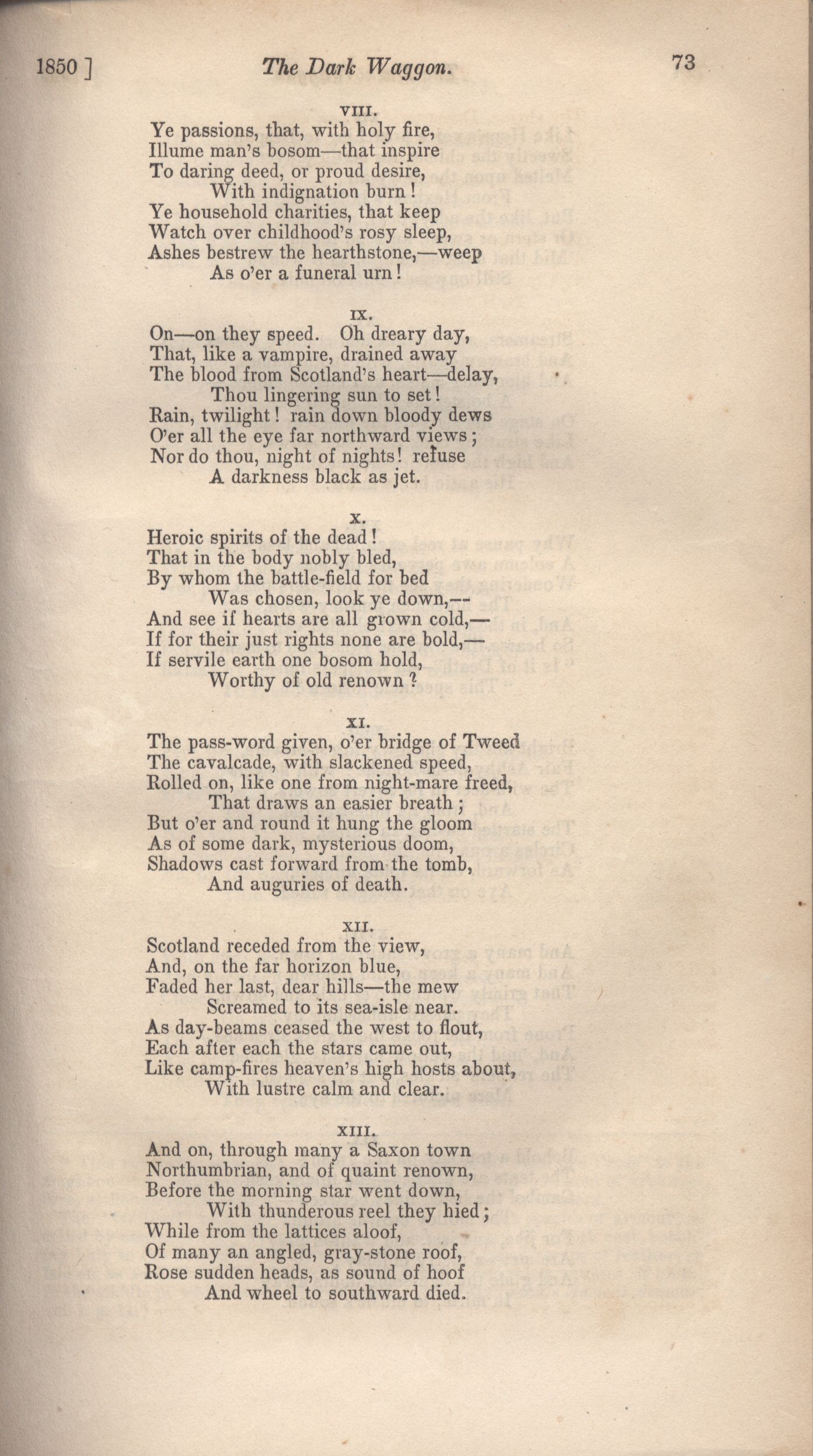
VIII.
Ye passions, that, with holy fire,57
Illume man’s bosom—that inspire58
To daring deed, or proud desire,59
With indignation burn !60
Ye household charities, that keep61
Watch over childhood’s rosy sleep,62
Ashes bestrew the hearthstone,—weep63
As o’er a funeral urn !64
IX.
On—on they speed. Oh dreary day,65
That, like a vampire, drained away66
The blood from Scotland’s heart—delay,67
Thou lingering sun to set !68
Rain, twilight ! rain down bloody dews69
O’er all the eye far northward views ;70
Nor do thou, night of nights ! refuse71
A darkness black as jet.72
X.
Heroic spirits of the dead !73
That in the body nobly bled,74
By whom the battle-field for bed75
Was chosen, look ye down,—76
And see if hearts are all grown cold,—77
If for their just rights none are bold,—78
If servile earth one bosom hold,79
Worthy of old renown ?80
XI.
The pass-word given, o’er bridge of Tweed81
The cavalcade, with slackened speed,82
Rolled on, like one from night-mare freed,83
That draws an easier breath ;84
But o’er and round it hung the gloom85
As of some dark, mysterious doom,86
Shadows cast forward from-the tomb,87
And auguries of death.88
XII.
Scotland receded from the view,89
And, on the far horizon blue,90
Faded her last, dear hills—the mew91
Screamed to its sea-isle near.92
As day-beams ceased the west to flout,93
Each after each the stars came out,94
Like camp-fires heaven’s high hosts about,95
With lustre calm and clear.96
XIII.
And on, through many a Saxon town97
Northumbrian, and of quaint renown,98
Before the morning star went down,99
With thunderous reel they hied ;100
While from the lattices aloof,101
Of many an angled, gray-stone roof,102
Rose sudden heads, as sound of hoof103
And wheel to southward died.104
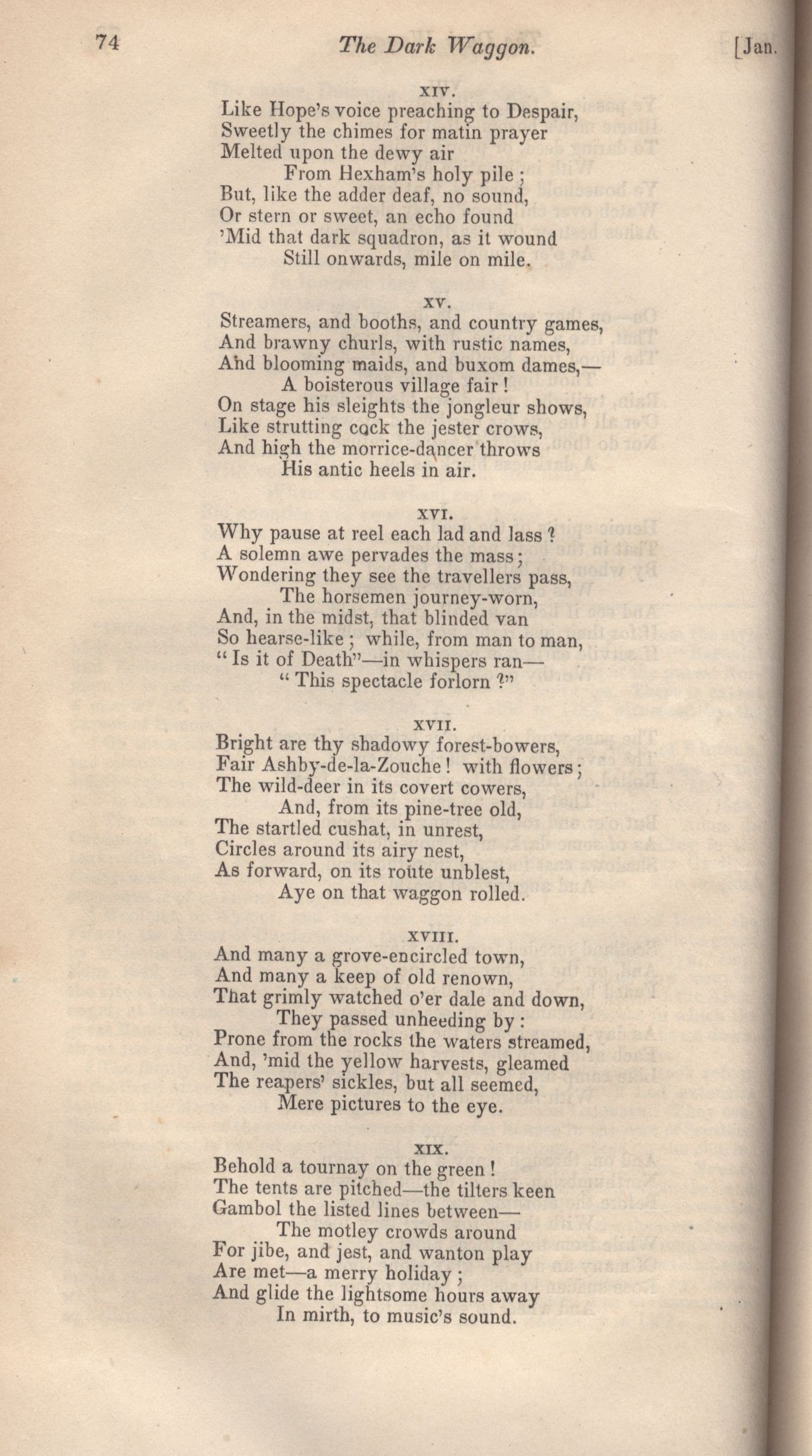
XIV.
Like Hope’s voice preaching to Despair,105
Sweetly the chimes for matin prayer106
Melted upon the dewy air107
From Hexham’s holy pile ;108
But, like the adder deaf, no sound,109
Or stern or sweet, an echo found110
’Mid that dark squadron, as it wound111
Still onwards, mile on mile.112
XV.
Streamers, and booths, and country games,113
And brawny churls, with rustic names,114
And blooming maids, and buxom dames,—115
A boisterous village fair !116
On stage his sleights the jongleur shows,117
Like strutting cock the jester crows,118
And high the morrice-dancer throws119
His antic heels in air.120
XVI.
Why pause at reel each lad and lass ?121
A solemn awe pervades the mass ;122
Wondering they see the travellers pass,123
The horsemen journey-worn,124
And, in the midst, that blinded van125
So hearse-like ; while, from man to man,126
“ Is it of Death”—in whispers ran—127
“ This spectacle forlorn ?”128
XVII.
Bright are thy shadowy forest-bowers,129
Fair Ashby-de-la-Zouche ! with flowers ;130
The wild-deer in its covert cowers,131
And, from its pine-tree old,132
The startled cushat, in unrest,133
Circles around its airy nest,134
As forward, on its route unblest,135
Aye on that waggon rolled.136
XVIII.
And many a grove-encircled town,137
And many a keep of old renown,138
That grimly watched o’er dale and down,139
They passed unheeding by :140
Prone from the rocks the waters streamed,141
And, ’mid the yellow harvests, gleamed142
The reapers’ sickles, but all seemed,143
Mere pictures to the eye.144
XIX.
Behold a tournay on the green !145
The tents are pitched—the tilters keen146
Gambol the listed lines between—147
The motley crowds around148
For jibe, and jest, and wanton play149
Are met—a merry holiday ;150
And glide the lightsome hours away151
In mirth, to music’s sound.152
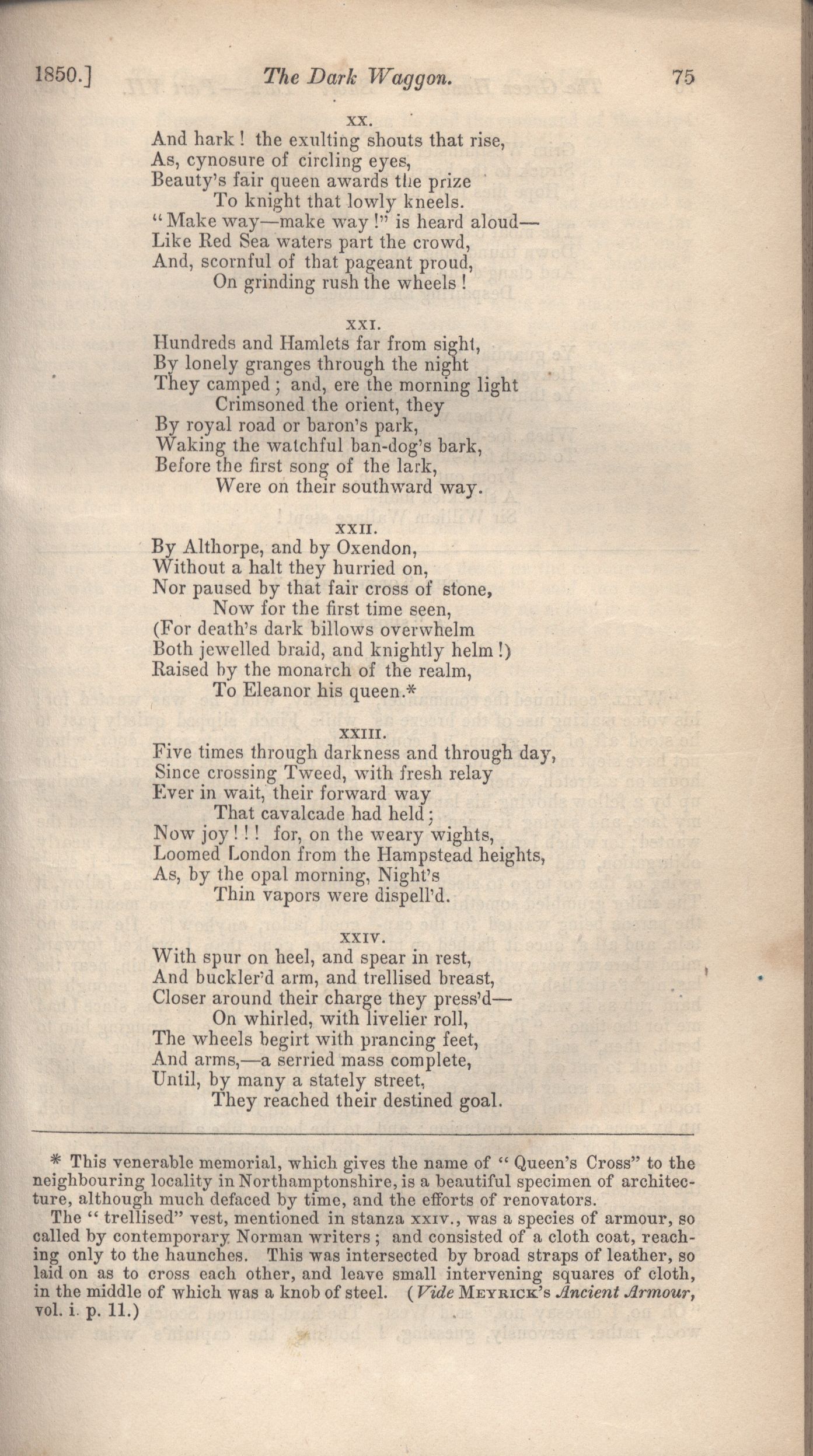
XX.
And hark ! the exulting shouts that rise,153
As, cynosure of circling eyes,154
Beauty’s fair queen awards the prize155
To knight that lowly kneels.156
“ Make way—make way !” is heard aloud—157
Like Red Sea waters part the crowd,158
And, scornful of that pageant proud,159
On grinding rush the wheels !160
XXI.
Hundreds and Hamlets far from sight,161
By lonely granges through the night162
They camped ; and, ere the morning light163
Crimsoned the orient, they164
By royal road or baron’s park,165
Waking the watchful ban-dog’s bark,166
Before the first song of the lark,167
Were on their southward way.168
XXII.
By Althorpe, and by Oxendon,169
Without a halt they hurried on,170
Nor paused by that fair cross of stone,171
Now for the first time seen,172
(For death’s dark billows overwhelm173
Both jewelled braid, and knightly helm !)174
Raised by the monarch of the realm,175
To Eleanor his queen.*176
XXII.
Five times through darkness and through day,177
Since crossing Tweed, with fresh relay178
Ever in wait, their forward way179
That cavalcade had held ;180
Now joy ! ! ! for, on the weary wights,181
Loomed London from the Hampstead heights,182
As, by the opal morning, Night’s183
Thin vapors were dispell’d.184
XXIV.
With spur on heel, and spear in rest,185
And buckler’d arm, and trellised breast,186
Closer around their charge they press’d—187
On whirled, with livelier roll,188
The wheels begirt with prancing feet,189
And arms,—a serried mass complete,190
Until, by many a stately street,191
They reached their destined goal.192
* This venerable memorial, which gives the name of “ Queen’s Cross” to the
neighbouring locality in Northamptonshire, is a beautiful specimen of architec-
ture, although much defaced by time, and the efforts of renovators.
neighbouring locality in Northamptonshire, is a beautiful specimen of architec-
ture, although much defaced by time, and the efforts of renovators.
The “ trellised” vest, mentioned in stanza XXIV., was a species of armour, so
called by contemporary, Norman writers ; and consisted of a cloth coat, reach-
ing only to the haunches. This was intersected by broad straps of leather, so
laid on as to cross each other, and leave small intervening squares of cloth,
in the middle of which was a knob of steel. (Vide Meyrick’s Ancient Armour, vol. i. p. 11.)
called by contemporary, Norman writers ; and consisted of a cloth coat, reach-
ing only to the haunches. This was intersected by broad straps of leather, so
laid on as to cross each other, and leave small intervening squares of cloth,
in the middle of which was a knob of steel. (Vide Meyrick’s Ancient Armour, vol. i. p. 11.)
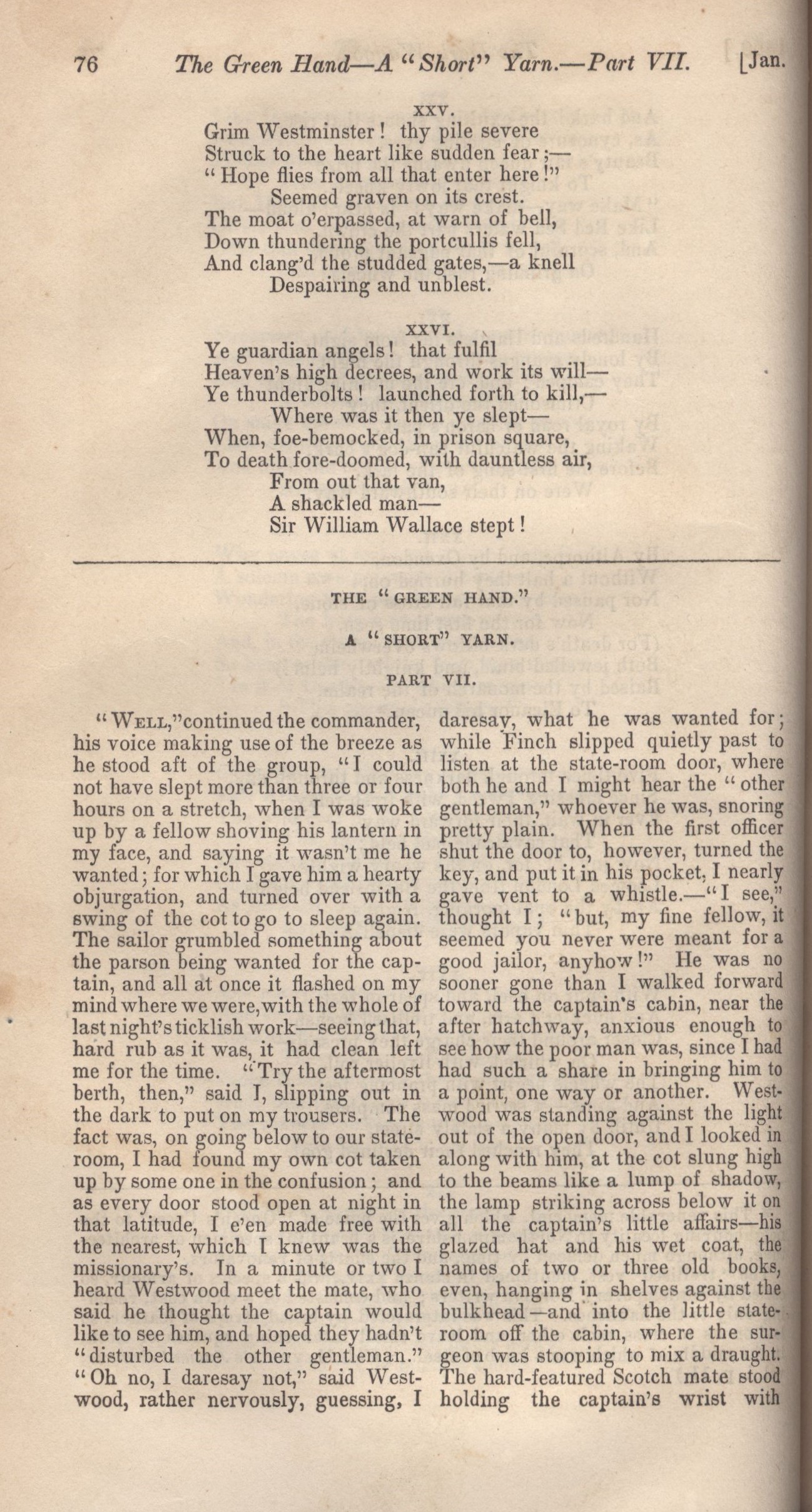
XXV.
Grim Westminster ! thy pile severe193
Struck to the heart like sudden fear ;—194
“ Hope flies from all that enter here !”195
Seemed graven on its crest.196
The moat o’erpassed, at warn of bell,197
Down thundering the portcullis fell,198
And clang’d the studded gates,—a knell199
Despairing and unblest.200
XXVI.
Ye guardian angels ! that fulfil201
Heaven’s high decrees, and work its will—202
Ye thunderbolts ! launched forth to kill,—203
Where was it then ye slept—204
When, foe-bemocked, in prison square,205
To death fore-doomed, with dauntless air,206
From out that van,207
A shackled man—208
Sir William Wallace stept !209